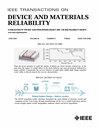A DLTS Study on Deep Trench Processing-Induced Trap States in Silicon Photodiodes
IF 2.5
3区 工程技术
Q2 ENGINEERING, ELECTRICAL & ELECTRONIC
IEEE Transactions on Device and Materials Reliability
Pub Date : 2024-03-27
DOI:10.1109/TDMR.2024.3382396
引用次数: 0
Abstract
We present a Deep Level Transient Spectroscopy (DLTS) study on dedicated test samples to investigate the defect landscape of deep trench (DT) sidewalls. The DT is commonly used to prevent crosstalk between two neighboring optoelectronic devices or as a separator between different functional blocks on a monolithic semiconductor chip. However, in minority carrier-based optoelectronic devices, such as photodiodes, carriers might recombine at trap states located at the DT to silicon interface causing performance degradation. The extracted parameters of the DLTS study are further utilized to investigate this recombination in terms of TCAD simulations. The results suggest that carrier recombination at the DT sidewalls of DT-terminated photodiodes may lead to non-linear responsivities with respect to the optical radiant flux. Furthermore, on the example of silicon dangling bonds, we investigate the influence of structural relaxations at the defect sites which are incorporated in the nonradiative multiphonon (NMP) model. By a comparison between the NMP model to the conventional Shockley-Read-Hall (SRH) model we show, that a difference in the emission barrier of approx. 50 meV will arise, resulting in a strong shift of the corresponding DLTS transients.关于硅光电二极管中深沟槽加工诱导陷阱状态的 DLTS 研究
我们对专用测试样品进行了深层瞬态光谱(DLTS)研究,以调查深沟槽(DT)侧壁的缺陷情况。深沟槽通常用于防止两个相邻光电器件之间的串扰,或用作单片半导体芯片上不同功能块之间的分隔物。然而,在光电二极管等基于少数载流子的光电器件中,载流子可能会在位于 DT 与硅界面的陷阱态上重新结合,从而导致性能下降。我们进一步利用 DLTS 研究中提取的参数,通过 TCAD 模拟来研究这种重组。结果表明,DT 端光电二极管 DT 侧壁的载流子重组可能会导致与光辐射通量有关的非线性响应率。此外,我们还以硅悬键为例,研究了非辐射多声子(NMP)模型中包含的缺陷点结构弛豫的影响。通过将 NMP 模型与传统的肖克利-雷德-霍尔(SRH)模型进行比较,我们发现发射势垒会出现约 50 meV 的差异,从而导致相应的 DLTS 瞬态发生强烈偏移。
本文章由计算机程序翻译,如有差异,请以英文原文为准。
求助全文
约1分钟内获得全文
求助全文
来源期刊

IEEE Transactions on Device and Materials Reliability
工程技术-工程:电子与电气
CiteScore
4.80
自引率
5.00%
发文量
71
审稿时长
6-12 weeks
期刊介绍:
The scope of the publication includes, but is not limited to Reliability of: Devices, Materials, Processes, Interfaces, Integrated Microsystems (including MEMS & Sensors), Transistors, Technology (CMOS, BiCMOS, etc.), Integrated Circuits (IC, SSI, MSI, LSI, ULSI, ELSI, etc.), Thin Film Transistor Applications. The measurement and understanding of the reliability of such entities at each phase, from the concept stage through research and development and into manufacturing scale-up, provides the overall database on the reliability of the devices, materials, processes, package and other necessities for the successful introduction of a product to market. This reliability database is the foundation for a quality product, which meets customer expectation. A product so developed has high reliability. High quality will be achieved because product weaknesses will have been found (root cause analysis) and designed out of the final product. This process of ever increasing reliability and quality will result in a superior product. In the end, reliability and quality are not one thing; but in a sense everything, which can be or has to be done to guarantee that the product successfully performs in the field under customer conditions. Our goal is to capture these advances. An additional objective is to focus cross fertilized communication in the state of the art of reliability of electronic materials and devices and provide fundamental understanding of basic phenomena that affect reliability. In addition, the publication is a forum for interdisciplinary studies on reliability. An overall goal is to provide leading edge/state of the art information, which is critically relevant to the creation of reliable products.
 求助内容:
求助内容: 应助结果提醒方式:
应助结果提醒方式:


